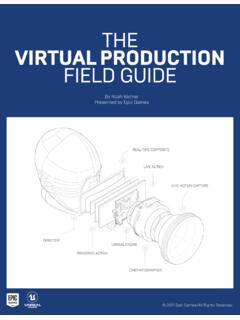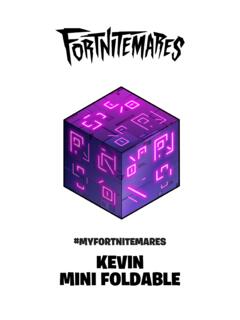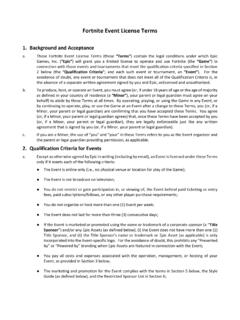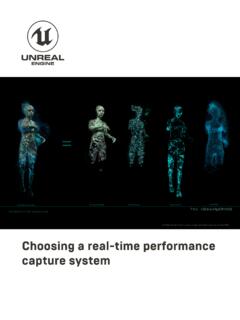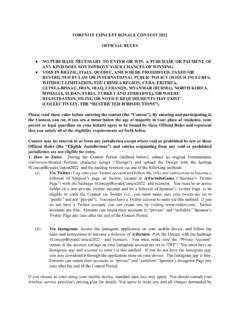Transcription of Real Shading in Unreal Engine 4
1 Real Shading inUnreal Engine 4by Brian Karis, Epic GamesFigure 1: UE4:Infiltrator demoIntroductionAbout a year ago, we decided to invest some time in improving our Shading model and embrace a morephysically based material workflow. This was driven partly by a desire to render more realistic images,but we were also interested in what we could achieve through a more physically based approach tomaterial creation and the use of material layering. The artists felt that this would be an enormousimprovement to workflow and quality, and I had already seen these benefits first hand at anotherstudio, where we had transitioned to material layers that were composited offline.
2 One of our technicalartists here at Epic experimented with doing the layering in the shader with promising enough resultsthat this became an additional order to support this direction, we knew that material layering needed to be simple and effi-cient. With perfect timing came Disney s presentation [2] concerning their physically based shadingand material model used forWreck-It Ralph. Brent Burley demonstrated that a very small set ofmaterial parameters could be sophisticated enough for offline feature film rendering. He also showedthat a fairly practical Shading model could closely fit most sampled materials.
3 Their work became aninspiration and basis for ours, and like their principles, we decided to define goals for our own system:Real-Time Performance First and foremost, it needs to be efficient to use with many lights visible at a Complexity Thereshould be as few parameters as possible. A large array of parameters either results indecision paralysis, trial and error, or interconnected properties that require many values to bechanged for a single intended effect. We need to be able to use image-based lighting and analytic light sources interchangeably, soparameters must behave consistently across all light Interface We prefer simple-to-understand values, as opposed to physical ones such as index of Linear We wish to support layering through masks, but we can only afford to shade once per pixel.
4 Thismeans that parameter-blended Shading must match blending of the shaded results as closely to Master We would like to avoid the need for technical understanding of dielectrics and conductors, as wellas minimize the effort required to create basic physically plausible It should be difficult to mistakenly create physically implausible materials. All combinations of parameters should be as robust and plausible as Deferred Shading limits the number of Shading models we can have, so our base Shading modelneeds to be descriptive enough to cover 99% of the materials that occur in the real world.
5 All layerable materials need to share the same set of parameters in order to blend between Other projects and licensees may not share the same goal of photorealism, so it needs to beflexible enough to enablenon-photorealistic ModelDiffuse BRDFWe evaluated Burley s diffuse model but saw only minor differences compared to Lambertian diffuse(Equation 1), so we couldn t justify the extra cost. In addition, any more sophisticated diffuse modelwould be difficult to use efficiently with image-based or spherical harmonic lighting.
6 As a result, wedidn t invest much effort in evaluating other (l,v) =cdiff (1)Wherecdiffis the diffusealbedo of the SpecularBRDFThe general Cook-Torrance [5,6] microfacet specular Shading model is:f(l,v) =D(h)F(v,h)G(l,v,h)4 (n l)(n v)(2)See [9] in this course for extensive started with Disney s model and evaluated the importance of each term compared with moreefficient alternatives. This was more difficult than it sounds; published formulas for each term don tnecessarily use the same input parameters which is vital for correct DFor the normal distribution function (NDF), we found Disney s choice of GGX/Trowbridge-Reitz tobe well worth the cost.
7 The additional expense over using Blinn-Phong is fairly small, and the distinct,natural appearance produced by the longer tail appealed to our artists. We also adopted Disney sreparameterization of = (h) = 2 ((n h)2( 2 1) + 1)2(3)Specular GWe evaluated more options for the specular geometric attenuation term than any other. In the end,we chose to use the Schlick model [19], but withk= /2, so as to better fit the Smith model forGGX [21]. With this modification, the Schlick model exactly matches Smith for = 1and is a fairlyclose approximation over the range [0, 1] (shown in Figure 2).
8 We also chose to use Disney s modificationto reduce hotness by remapping roughness usingRoughness+12before s important to notethat this adjustment is only used for analytic light sources; if applied to image-based lighting, theresults at glancing angles will be much too (Roughness+ 1)28G1(v) =n v(n v)(1 k) +kG(l,v,h) =G1(l)G1(v)(4)Specular FFor Fresnel, we made the typical choice of using Schlick s approximation [19], but with a minor mod-ification: we use aSpherical Gaussianapproximation [10] to replace the power.
9 It is slightly moreefficient to calculate and the difference is imperceptible. The formula is:F(v,h) =F0+ (1 F0) 2( 5:55473(v h) 6:98316)(v h)(5)WhereF0is the specular reflectance at normal 2: Schlick withk= /2matches Smith very closelyImage-Based LightingTo use this Shading model with image-based lighting, the radiance integral needs to be solved, whichis often done using importance sampling. The following equation describes this numerical integration: HLi(l)f(l,v)cos ldl 1NN k=1Li(lk)f(lk,v)cos lkp(lk,v)(6)The followingHLSL code shows how to do this with our Shading model:float3 ImportanceSampleGGX(float2Xi,floatRoughn ess,float3N ){float a = Roughness * Roughness;float Phi = 2 * PI * ;float CosTheta =sqrt( (1 - ) / ( 1 + (a*a - 1) * ) );float SinTheta =sqrt( 1 - CosTheta * CosTheta );float3H; SinTheta *cos ( Phi ); SinTheta *sin ( Phi ); CosTheta;float3 UpVector =abs ( ) < ?}
10 Float3(0,0,1) :float3(1,0,0);float3 TangentX =normalize( cross( UpVector, N ) );float3 TangentY =cross( N, TangentX );// Tangent to world spacereturnTangentX * + TangentY * + N * ;}float3 SpecularIBL(float3 SpecularColor,floatRoughness,float3N, float3V ){float3 SpecularLighting = 0;const uintNumSamples = 1024;for ( uinti = 0; i < NumSamples; i++ ){float2Xi = Hammersley( i, NumSamples );4float3H = ImportanceSampleGGX( Xi, Roughness, N );float3L = 2 *dot ( V, H ) * H - V;float NoV =saturate( dot ( N, V ) );float NoL =saturate( dot ( N, L ) );float NoH =saturate( dot ( N, H ) );float VoH =saturate( dot ( V, H ) );if ( NoL > 0 ){float3 SampleColor = ( EnvMapSampler, L, 0 ).}}
